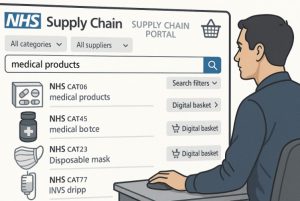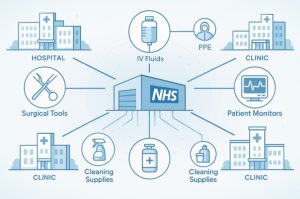The NHS Supply Chain catalogue plays a vital role in the UK’s healthcare procurement system. With access to over 600,000 products, it enables NHS professionals to source medical supplies, equipment, and essential services efficiently.
This digital catalogue is updated daily, offering real-time product information, availability, and alternatives. Understanding how the system works and how to navigate it effectively is key to ensuring smooth operations, cost control, and uninterrupted patient care across NHS Trusts and healthcare settings.
The NHS Supply Chain catalogue serves as the central repository for healthcare organisations to procure essential supplies, products, and equipment. It plays a vital role in ensuring NHS Trusts can access more than 600,000 approved products across multiple categories. This system supports both clinical operations and administrative functions within NHS facilities.
Its importance lies in its ability to bring together a wide range of items under a standardised procurement framework. This allows Trusts to benefit from consistent pricing, regulated product quality, and national-level supplier agreements. The catalogue also ensures greater control over expenditure, inventory levels, and supplier relationships, making it a fundamental part of NHS procurement strategy.
How Does the NHS Supply Chain Catalogue Work?
The NHS Supply Chain catalogue operates as a centralised digital platform that integrates healthcare procurement across the NHS in England. It is designed to provide authorised users with streamlined access to a vast product range, real-time data, and supply chain services. The catalogue supports both strategic procurement planning and day-to-day ordering needs for NHS organisations.
At its core, the catalogue is powered by a dynamic online system that connects healthcare providers to pre-approved suppliers through secure portals and procurement frameworks. It is continuously updated to reflect product availability, pricing, contract details, and supply chain changes. The system works in conjunction with NHS Supply Chain’s various fulfilment models, such as eDirect, stock replenishment services, and national distribution centres.
Key operational features include:
- Real-Time Data Synchronisation: The catalogue is updated daily to provide current information on product stock levels, pricing, and alternative options. This ensures that procurement teams are working with accurate data when placing orders or making purchasing decisions.
- Integrated Ordering Systems: The NHS Supply Chain catalogue connects with local trust finance and procurement systems through eProcurement integrations. This compatibility allows for seamless transaction processing, automated approvals, and visibility of spend across departments.
- Product Visibility and Detail: Each product listed in the catalogue contains detailed information such as pack sizes, unit prices, clinical specifications, delivery timelines, and supplier information. If a product is suspended, the system highlights the reason (e.g. quality issues, supplier disruption) and offers recommended alternatives.
- Advanced Search Functionality: Users can locate products by entering product codes, item names, or category filters. Results can be refined by availability, contract type, supplier, or clinical application.
- User Access Management; Access is role-based. Procurement officers, inventory managers, and authorised clinical leads each have different permission levels, ensuring control and traceability of purchasing activities.
- Sustainability and Compliance Tools; Products aligned with NHS Net Zero goals are marked with sustainability indicators, allowing Trusts to make greener purchasing decisions.
This infrastructure ensures procurement efficiency while supporting national targets for cost savings, regulatory compliance, and supply chain resilience.
Who Can Access the NHS Supply Chain Catalogue?

Access to the catalogue is restricted to authorised NHS staff involved in procurement, inventory management, and clinical operations. Each user is assigned a role, and permissions are tailored to specific job functions.
Authorised users include:
- Procurement officers
- Inventory controllers
- Departmental administrators
- Clinical leads involved in supply management
Login credentials are provided through the NHS Supply Chain portal. Once logged in, users can place orders, manage product lists, and generate procurement reports. Different permission levels allow Trusts to control who can view, order, or approve products, supporting internal governance and audit requirements.
What Types of Products Are Available in the NHS Supply Chain Catalogue?
The NHS Supply Chain catalogue is expansive, encompassing more than 600,000 products across clinical, non-clinical, and administrative categories. It is designed to meet the complete supply needs of hospitals, clinics, community health services, and NHS support services.
Products are categorised to support specific areas of patient care, operational management, and regulatory compliance. The catalogue is curated to ensure consistency, quality, and availability, with contributions from over 900 suppliers through centrally managed procurement frameworks.
Medical and Surgical Consumables
This category includes essential clinical supplies used in frontline healthcare services. Products range from routine use items to specialised equipment required in surgical and critical care settings.
Examples include:
- Intravenous therapy sets and cannulas
- Catheters and urological care kits
- Wound dressings and closure systems
- Surgical gloves, gowns, and drapes
- Diagnostic consumables such as blood collection tubes and swabs
Each product is compliant with medical safety standards and is often linked to specific NHS clinical pathways.
Aids for Daily Living
These products are designed to support patient mobility, comfort, and personal care both in clinical settings and at home.
Commonly used items in this category:
- Pressure-relieving mattresses and seating cushions
- Transfer aids like hoists and slide sheets
- Mobility devices including walking frames and crutches
- Incontinence care items and hygiene support products
These aids are essential for occupational therapy and community health services.
Facilities and Office Solutions
Non-clinical products required for facility maintenance, hygiene, and administration are also available through the catalogue. These ensure that NHS premises operate efficiently and meet environmental health standards.
This includes:
- Cleaning chemicals and janitorial equipment
- PPE for non-clinical staff
- Office supplies such as printers, stationery, and IT accessories
- Waste disposal solutions including sharps bins and clinical waste bags
Facilities solutions are aligned with procurement contracts that prioritise sustainability, energy efficiency, and cost control.
Nationally Contracted Products (NCPs)
NCPs are a strategic part of the NHS procurement plan. These products are centrally selected based on usage data and clinical effectiveness to ensure consistency across Trusts and leverage the NHS’s buying power.
Features of NCPs:
- Standardisation of high-volume product lines
- Aggregated purchasing for better value
- Fixed national pricing
- Reduced variation in clinical outcomes
Typical NCP items include gloves, syringes, dressings, and surgical packs.
Additional Specialised Categories
Beyond the core categories, the catalogue also includes:
- Orthotics and prosthetics for rehabilitation
- Physiotherapy equipment such as resistance bands and mobility trainers
- Pathology and laboratory diagnostics
- Sterile services equipment
- Imaging accessories for radiology departments
These specialised areas are supported through curated supplier frameworks, ensuring compliance with clinical governance and regulatory standards.
Catalogue Functionality Overview
| Category | Product Examples | Department Use Cases |
| Medical Consumables | Gloves, syringes, dressings | Wards, theatres, emergency care |
| Aids for Daily Living | Mobility aids, pressure care, hygiene items | Community care, long-term care, rehab units |
| Facilities & Office | Cleaning tools, PPE, office equipment | Estates, admin teams, general operations |
| NCP Items | Standardised dressings, cannulas, surgical gloves | All NHS Trusts |
| Specialised Clinical Products | Orthotics, diagnostics, radiology accessories | Pathology, therapy, imaging units |
The NHS Supply Chain catalogue ensures that each NHS organisation can procure what it needs—reliably, affordably, and with clinical assurance.
How to Search and Order Through the NHS Supply Chain Catalogue?

The ordering process is intuitive and built around functionality that allows users to find, compare, and procure products quickly and accurately. The search functionality enables users to refine results using multiple filters including product status, pricing, and availability.
Key steps include:
- Log in to the NHS Supply Chain portal
- Use the advanced search to input product codes, keywords, or supplier names
- Apply filters to exclude inactive or suspended items
- Compare product options and alternatives where applicable
- Add selected items to the basket and submit orders based on procurement permissions
Below is an overview of features that improve order accuracy:
| Feature | Purpose |
| Advanced Search | Enables keyword or code-based lookup |
| Inactive Product Exclusion | Filters out unavailable items from results |
| Alternative Product Suggestions | Offers direct and indirect replacement products |
| Product Amendments Log | Displays changes in price, pack size, or supply route |
Product records within the catalogue also display rich detail such as technical specifications, associated images, and stock location data. This assists NHS procurement staff in making confident and compliant purchasing decisions.
What Are the Benefits of Using the NHS Supply Chain Catalogue Efficiently?
Effective use of the catalogue leads to a more streamlined supply process, reduced administrative burden, and improved patient care through timely access to essential products. Cost management and procurement transparency are also enhanced when staff use the system to its full potential.
Key benefits include:
- Cost efficiency through centralised pricing agreements
- Better inventory control using real-time stock data
- Faster decision-making from accurate product details
- Reduced waste by managing consumption and stock rotation
- Improved patient outcomes through consistent product availability
The ability to consolidate orders and avoid overstocking also contributes to environmental sustainability and financial accountability within Trusts.
What Are Some Common Challenges When Using the NHS Catalogue and How to Overcome Them?
Despite its efficiency, the NHS Supply Chain catalogue can pose some challenges, particularly for users unfamiliar with its functionality or working across multiple departments.
Common issues include:
- Difficulty locating specific product codes
- Incomplete or outdated search terms
- Navigational complexity for new users
- Suspended or temporarily unavailable items
To address these challenges, Trusts are encouraged to:
- Conduct regular staff training and onboarding sessions
- Create bookmarked lists of frequently used products
- Set up automated reorder points for high-demand items
- Use helpdesk support for technical issues
A well-managed user environment and regular system engagement help reduce errors and improve overall user satisfaction.
How Can NHS Staff Optimise Procurement with the NHS Catalogue?
Procurement performance can be significantly improved when staff engage with the catalogue proactively and strategically. Beyond basic ordering, the system supports insights and analytics that help organisations plan more effectively and reduce unnecessary expenditure.
Here’s a table of recommended practices for catalogue optimisation:
| Optimisation Strategy | Benefit |
| Establish Preferred Supplier Lists | Reduces decision time and ensures compliance with contracts |
| Review Spend History Reports | Identifies cost-saving opportunities |
| Monitor Product Amendments | Keeps order quantities and specifications up to date |
| Automate Frequent Orders | Saves time and prevents stockouts |
Utilising these features not only enhances procurement efficiency but also supports clinical departments in maintaining continuous and reliable service delivery.
How Secure and Compliant Is the NHS Supply Chain Catalogue?
Security and regulatory compliance are fundamental to the NHS Supply Chain platform. The system has been built to ensure data integrity, confidentiality, and traceability across all transactions.
The catalogue is compliant with:
- General Data Protection Regulation (GDPR)
- Public Contracts Regulations 2015
- NHS Digital Information Governance Toolkit
Access is protected by secure login protocols, and all user activity is logged for auditing purposes. Regular system updates and supplier vetting processes are also in place to maintain safety and service standards.
What’s the Future of the NHS Supply Chain Catalogue?

As technology evolves, the NHS Supply Chain is adapting to include more automation, predictive tools, and sustainability-focused features. Digital enhancements aim to reduce procurement timelines, eliminate errors, and support greener healthcare initiatives.
Expected developments include:
- Mobile-accessible catalogue interfaces
- AI-powered search and demand forecasting
- Enhanced data analytics dashboards
- Integration of carbon impact data for sustainable procurement
These innovations will further align NHS procurement with clinical excellence, digital transformation, and financial control.
Conclusion
The NHS Supply Chain catalogue is more than just a procurement tool—it’s a strategic asset for managing healthcare resources efficiently. NHS professionals should approach it with a clear understanding of its capabilities, keep up with daily updates, and ensure their teams are trained to navigate and use the system effectively.
By doing so, they will enhance procurement efficiency, reduce unnecessary spending, and support consistent patient care across the NHS.
FAQs About NHS Supply Chain Catalogue
What is the difference between eDirect and standard ordering through NHS Supply Chain?
eDirect is a direct delivery model for items that are not stocked centrally, allowing NHS Trusts to receive products straight from suppliers.
How often is the NHS Supply Chain catalogue updated?
The online catalogue is updated daily with changes in availability, pricing, alternatives, and new product entries.
Can NHS suppliers list their products in the NHS catalogue?
Yes, suppliers must go through a qualification and approval process managed by the NHS Supply Chain to have their products listed.
How can I find alternatives if a product is suspended?
The catalogue provides direct and indirect alternatives under each product entry, including stock status and supplier options.
What are Nationally Contracted Products (NCPs) and how do they help?
NCPs standardise high-use items across the NHS, improving value through bulk purchasing and ensuring consistent quality.
Is training available for using the NHS Supply Chain system?
Yes, NHS Supply Chain offers training sessions, user guides, and webinars to help staff navigate the system effectively.
How does the NHS Supply Chain ensure product quality?
All suppliers undergo rigorous assessment, and products must meet NHS clinical, safety, and regulatory standards before being listed.









